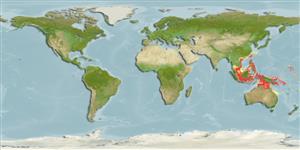Common names from other countries
>
Eupercaria/misc (Various families in series Eupercaria) >
Labridae (Wrasses)
Etymology: Leptojulis: Greek, leptos = thin + Greek, ioulis, a fish dealing with genera Coris or Thalassoma (Ref. 45335); urostigma: From a Greek word meaning 'tail spot', referring to the large balck spot on the base of the caudal fin, its most diagnostic feature..
More on author: Randall.
Environment: milieu / climate zone / depth range / distribution range
Ecologia
marinhas demersal; intervalo de profundidade 7 - 100 m (Ref. 12420). Tropical
Western Pacific: Taiwan, Philippines, Indonesia, and Papua New Guinea.
Tamanho / Peso / Idade
Maturity: Lm ? range ? - ? cm
Max length : 11.0 cm TL macho/indeterminado; (Ref. 48636)
Occurs solitary or in small groups (Ref. 90102) on muddy bottoms, often deep in front of river mouths where land debris is scattered over the bottom; sometimes takes refuge in the mud burrows of other animals. Adults were all seen in about 30 m and usually swim fast near the bottom (Ref. 48636). Feeds on benthic animals (polychaete worms, crustaceans, also small fish) (Ref. 12420). Minimum depth of 7 m from Ref. 90102.
Ciclo de vida ou comportamento de acasalamento
Maturities | Reprodução | Spawnings | Egg(s) | Fecundities | Larvas
Oviparous, distinct pairing during breeding (Ref. 205).
Randall, J.E., 1996. Second revision of the labrid fish genus Leptojulis, with descriptions of two new species. Indo-Pac. Fish. (24):20 p. (Ref. 12420)
Status na Lista Vermelha da UICN (Ref. 130435)
CITES (Ref. 128078)
Not Evaluated
Ameaça para os humanos
Harmless
Uso pelos humanos
Ferramentas
Relatórios especiais
Baixar XML
Fontes da internet
Estimates based on models
Preferred temperature (Ref.
115969): 26.5 - 29, mean 28 (based on 552 cells).
Índice de diversidade filogenética (Ref.
82804): PD
50 = 0.5312 [Uniqueness, from 0.5 = low to 2.0 = high].
Bayesian length-weight: a=0.00501 (0.00207 - 0.01214), b=3.15 (2.94 - 3.36), in cm Total Length, based on LWR estimates for this (Sub)family-body shape (Ref.
93245).
Nível Trófico (Ref.
69278): 3.7 ±0.54 se; based on food items.
Resiliência (Ref.
120179): Elevada, tempo mínimo de duplicação da população menor que 15 meses (Preliminary K or Fecundity.).
Fishing Vulnerability (Ref.
59153): Low vulnerability (10 of 100).
